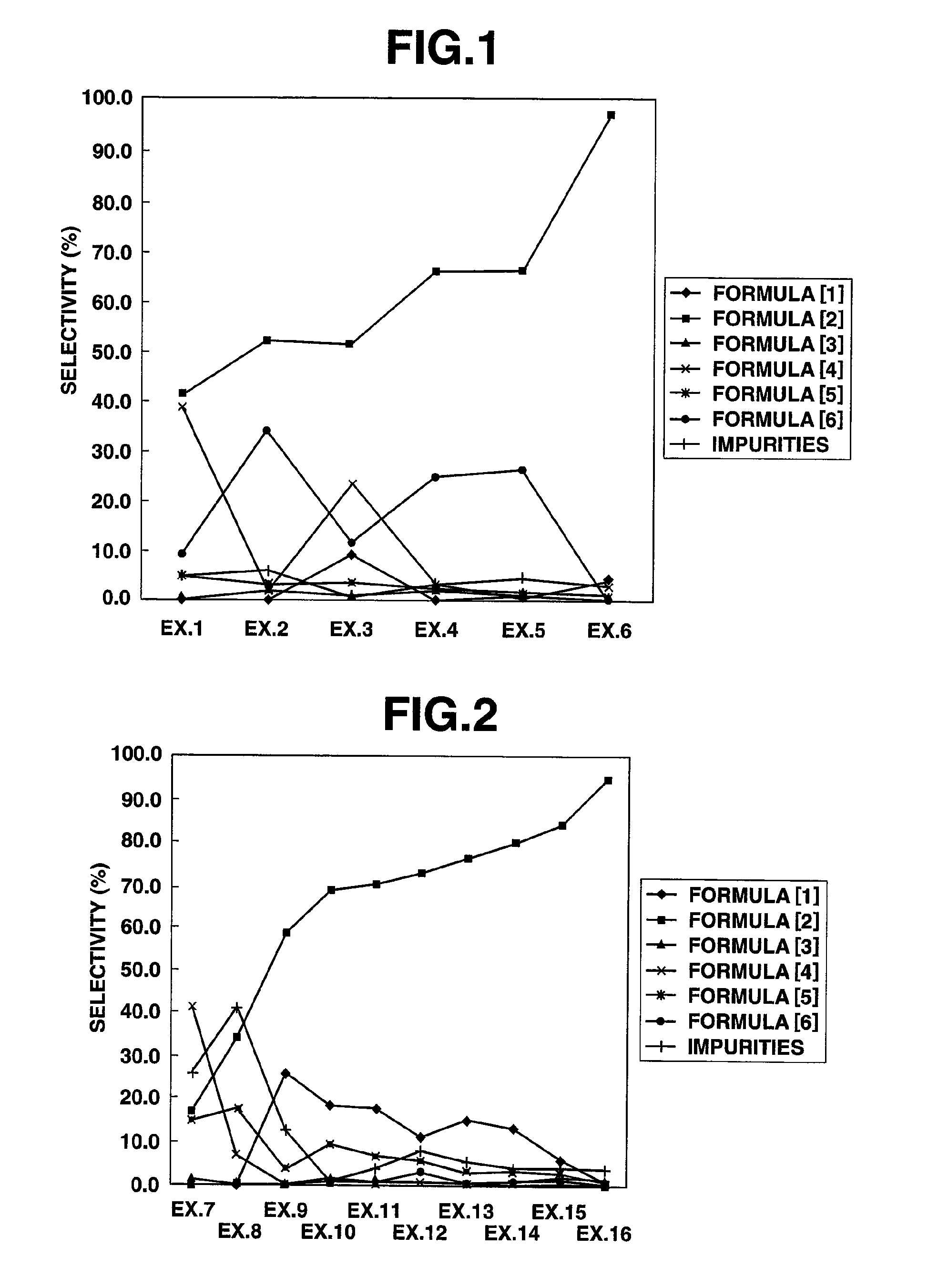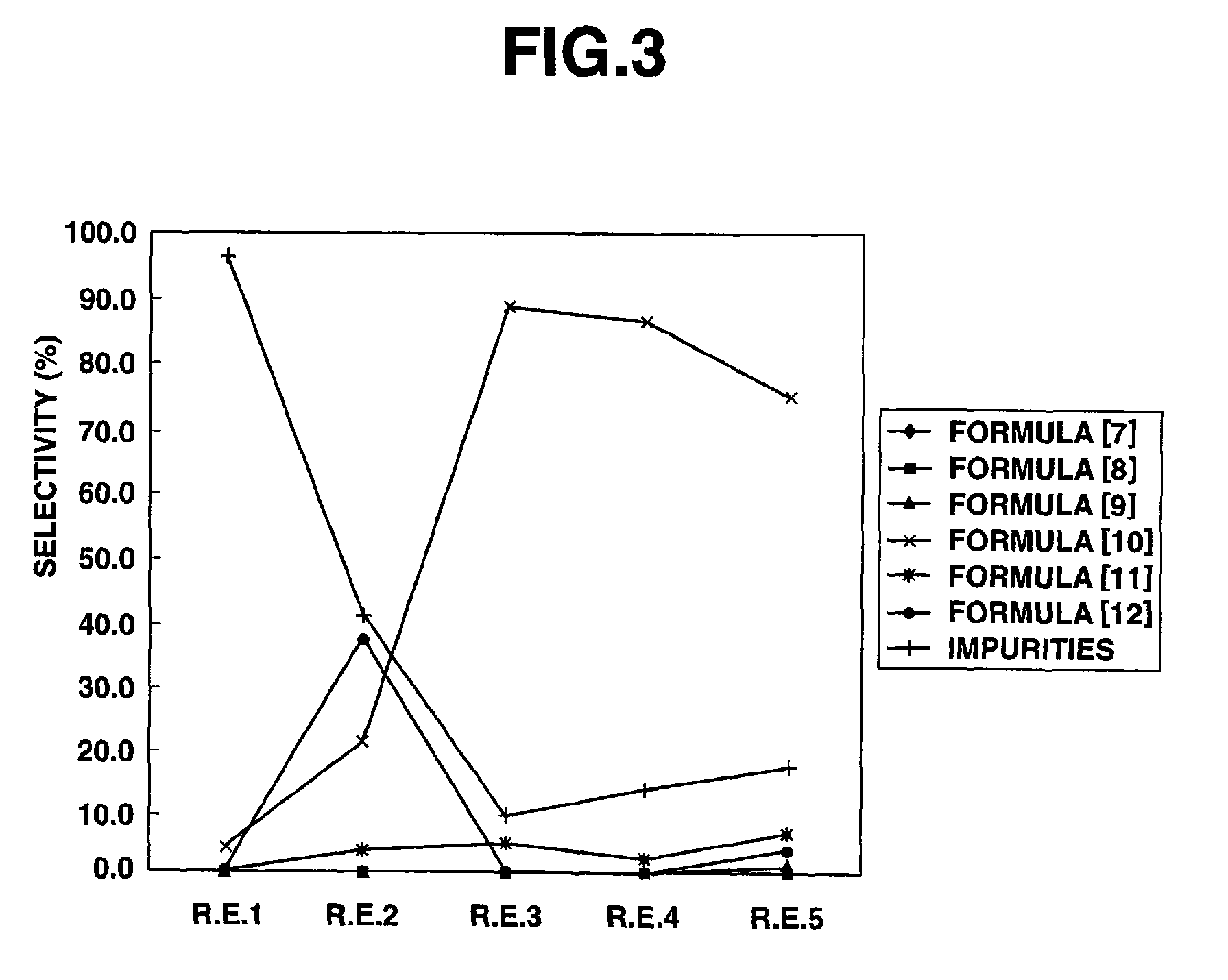Method for producing 3,3,3-trifluoropropionyl chloride
a technology of trifluoropropionic acid and trifluoropropionic acid, which is applied in the preparation of carboxylic compound, carboxylic compound, carbonyl compound, etc., can solve the problems of high corrosiveness of 3,3,3-trifluoropropionic acid itself, difficult handling in large amount, etc., and achieves higher selectivity and improves the selectivity of 3,3,3-trifluoropropionic acid.
- Summary
- Abstract
- Description
- Claims
- Application Information
AI Technical Summary
Benefits of technology
Problems solved by technology
Method used
Image
Examples
example 1
Production of 3,3,3-trifluoropropionyl Chloride; Chlorine
[0079]A 50 ml, three-necked, glass flask equipped with a magnetic stirrer, a flowmeter, a thermometer, a condenser tube and a chlorine eliminating equipment was charged with 100 g (0.892 mol) of 3,3,3-trifluoropropionaldehyde, followed by heating to 50° C. under stirring. To this, chlorine (2.18 mol) was introduced at around 50° C. at a flow rate of 200 ml / min for 4 hours. Then, the reaction liquid was found by gas chromatography measurement to be 41.3% of 3,3,3-trifluoropropionyl chloride, 0.1% of 3,3,3-trifluoropropionic acid, 39.0% of 3,3,3-trifluoro-2-chloropropionaldehyde, 5.4% of 3,3,3-trifluoro-2,2-dichloropropionaldehyde, 9.2% of 3,3,3-trifluoro-2-chloropropionyl chloride and 5.0% of other impurities.
Spectrum Data
3,3,3-trifluoropropionyl chloride;
[0080]1H-NMR spectrum (400 MHz, CDCl3) δ (ppm): 3.75 (2H, q, J=9.2 Hz)
[0081]19F-NMR spectrum (400 MHz, CDCl3) δ (ppm): −64.85 (3F, t, J=9.2 Hz)
[0082]Mass spectrum (Obsd m / z); ...
example 2
Production of 3,3,3-Trifluoropropionyl Chloride; Chlorine and AIBN
[0092]A 50 ml, three-necked, glass flask equipped with a magnetic stirrer, a flowmeter, a thermometer, a condenser tube and a chlorine eliminating equipment was charged with 30.0 g (0.268 mol) of 3,3,3-trifluoropropionaldehyde and 0.870 g (0.0053 mol) of 2,2′-azobis(2-methypropionitrile), followed by heating to 50° C. under stirring. To this, chlorine (0.218 mol) was introduced at around 50° C. at a flow rate of 20 ml / min for 4 hours. Then, the reaction liquid was found by gas chromatography measurement to be 52.2% of 3,3,3-trifluoropropionyl chloride, 1.8% of 3,3,3-trifluoropropionic acid, 2.9% of 3,3,3-trifluoro-2-chloropropionaldehyde, 3.1% of 3,3,3-trifluoro-2,2-dichloropropionaldehyde, 34.0% of 3,3,3-trifluoro-2-chloropropionyl chloride and 6.0% of other impurities.
example 3
Production of 3,3,3-trifluoropropionyl Chloride; Chlorine and 2,4-dichlorobenzotrifluoride)
[0093]A 50 ml, three-necked, glass flask equipped with a magnetic stirrer, a flowmeter, a thermometer, a condenser tube and a chlorine eliminating equipment was charged with 30.0 g (0.268 mol) of 3,3,3-trifluoropropionaldehyde and 30.0 g of 2,4-dichlorobenzotrifluoride, followed by heating to 50° C. under stirring. To this, chlorine (0.218 mol) was introduced at around 50° C. at a flow rate of 20 ml / min for 4 hours. Then, the reaction liquid was found by gas chromatography measurement to be 9.0% of 3,3,3-trifluoropropionaldehyde of the raw material, 51.2% of 3,3,3-trifluoropropionyl chloride, 0.8% of 3,3,3-trifluoropropionic acid, 23.4% of 3,3,3-trifluoro-2-chloropropionaldehyde, 3.6% of 3,3,3-trifluoro-2,2-dichloropropionaldehyde, 11.5% of 3,3,3-trifluoro-2-chloropropionyl chloride and 0.5% of other impurities.
PUM
| Property | Measurement | Unit |
|---|---|---|
| relative dielectric constant | aaaaa | aaaaa |
| dielectric constant | aaaaa | aaaaa |
| temperature | aaaaa | aaaaa |
Abstract
Description
Claims
Application Information
 Login to View More
Login to View More - R&D
- Intellectual Property
- Life Sciences
- Materials
- Tech Scout
- Unparalleled Data Quality
- Higher Quality Content
- 60% Fewer Hallucinations
Browse by: Latest US Patents, China's latest patents, Technical Efficacy Thesaurus, Application Domain, Technology Topic, Popular Technical Reports.
© 2025 PatSnap. All rights reserved.Legal|Privacy policy|Modern Slavery Act Transparency Statement|Sitemap|About US| Contact US: help@patsnap.com



